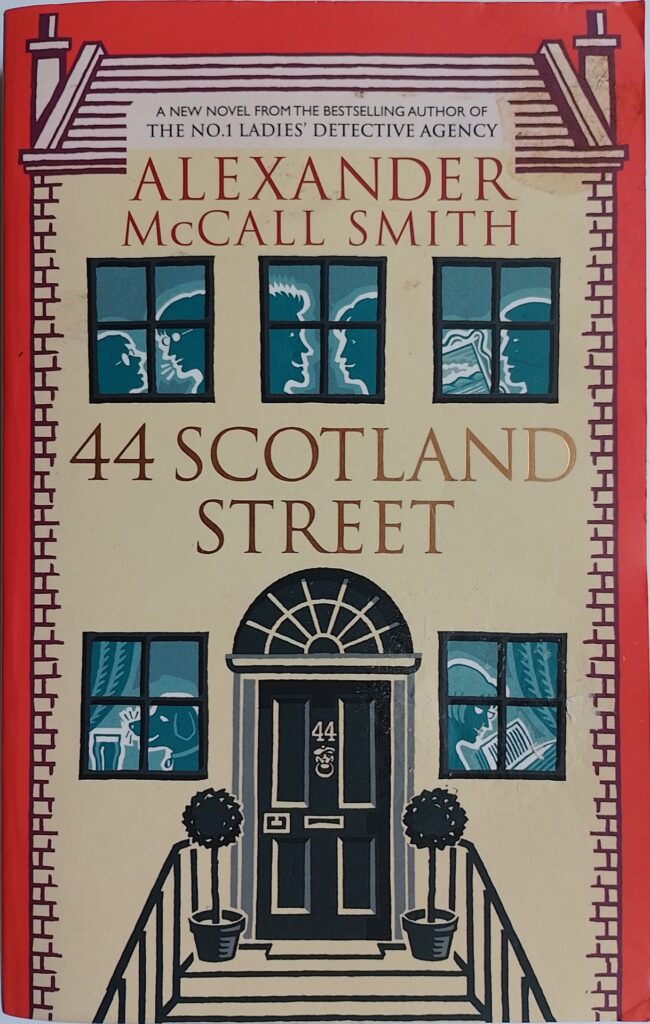First published 2005. Abacus, paperback, 2006, pp 326, c. 100,000 words.
McCall Smith is a prolific author (who has currently had published twenty-two books, plus four spin-off children’s books) is best known for his The No. 1 Ladies Detective Agency series, those lightly charming stories set in contemporary Africa that present such a positive and delightful image of a continent that is so often portrayed in Europe and America in a depressing light. Here he brings that same light touch to his native Edinburgh.
As usual, I avoided reading the preface before reading the text because they always influence how one perceives a book, and occasionally contain plot spoilers. In this case it might have been as well to read it first because it describes how the book was first written and published as a daily serial in The Scotsman newspaper. This explains the rather odd structure which consists of 110 short chapters, each of which stands as a little episode of action. It must have been a delight to read a daily episode in the paper as a distraction from all the miserable news, but it is not entirely successful in making for a smooth read as a novel.
44 Scotland Street is a building divided into flats and placed in Edinburgh’s New Town, that smart Georgian neighbourhood. The flats are mostly populated by nice(ish) middle-class people and the story revolves around the occupants of three of those flats and some of their work colleagues, their families and friends. The leading character, Pat, is a woman of twenty ‘on her second gap year’ who moves in to one of the flats as a lodger. The other occupant of that flat is a beautiful and narcissistic man of around thirty.
At one level, one can read this book as an exploration of beauty. The beautiful male and the reaction of women to him, but also beauty of the city and beauty in art. The importance given to beauty is a determinant of character, although it is not a straightforward relationship. One can be enthralled by the beautiful and yet find its embodiment repelling. The presence of the beautiful can make someone ‘…become intoxicated with it. We want to be with it. We want to possess it.’ [p191]. Later: ‘We want to possess it. We want to be it.’ [p257] There is an anecdote of a school teacher brining a class of girls to Firenze where they encounter the statue of David. ‘Remember this is Art’ says the teacher [p187]; a statement that can be read on so many levels.
Art, as in painting, also has a central role. Pat gets a job in a gallery and there is a running shaggy-dog story about a painting that might be by Samuel Peploe. There is fun with Jack Vettriano, not all of which is negative.
This book is also a love letter to Edinburgh. The city and its characters are well evoked. It is a positive image, unlike the one of Ian Rankin’s Rebus. Amusingly, Rankin gets a cameo appearance in this book, as do several other well-known real residents of the city. There is a nice riff on the time taken to build the Scottish Parliament building and on its design.
The structure is the book’s principle weakness. Points of view revolve rapidly. Occasionally a bit-part player gets to inject their take on proceedings in a paragraph which sometimes feels shoe-horned in to provide a joke. The other flaw presumably arose from the need to keep up with the newspaper’s deadlines: the occasional lapse into rather dull philosophising as a character expounds the author’s opinions. A serious edit after a first draft might have removed or improved these flaws.
Overall this is a nice, easy read, lightly amusing and entertaining. The exploration of the theme of beauty from an unusual angle gives it a little bit of depth.
© William John Graham, January 2023

